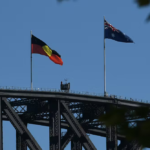Up close and personal with White Island

Four years ago, I was holidaying on New Zealand’s north island, when I learned that it was possible to visit White Island, also known as Whakaari.
It wasn’t cheap, but this was adventure tourism at its best, and I jumped at the chance.
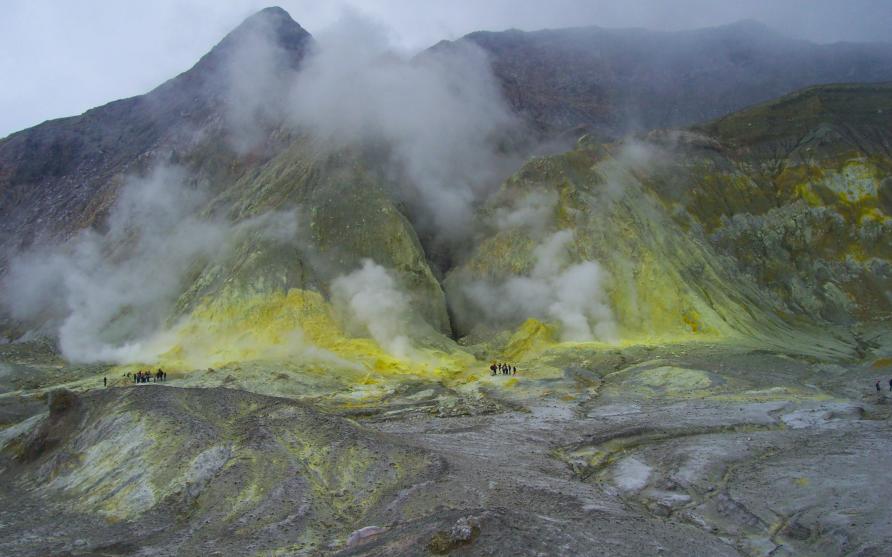
Walking into the basin, with walls of volcanic tuff (ash transformed into rock) on three sides.
I knew there was a risk, but the volcano had been quiescent for a few years, and I reasoned ‘what could go wrong on a commercial tour?’
But this week, we’ve been reminded of the unpredictability of our planet, as the death toll from the recent devastating volcanic eruption continues to climb.
When I travelled to White Island, our attention was drawn to the risk to shoes and clothes, so I rushed out to buy some cheap sneakers and a windproof (and possibly acid-proof) jacket.
Others in the thirty-strong visiting party were much better dressed than I was, but I was snug in my adventurer gear. I still have the gear today, but it faces nothing more challenging than the garden and work with my environment group.
A powerful launch took us north from Whakatane to the island about 50 kilometres offshore. It took almost two hours, and from about the halfway point we could see the plume of steam and smoke from the volcano.
As we neared the island, our boat was surrounded by diving gannets and, as we got closer, we could see their nesting colony on the western slope, unaffected by the prevailing winds that blew the toxic gases away to the east.
The launch moored offshore and we were taken by runabout, from which we scaled a ladder to the pier.
It was hard work and I felt every one of my 78 years – but there was more exertion to come.
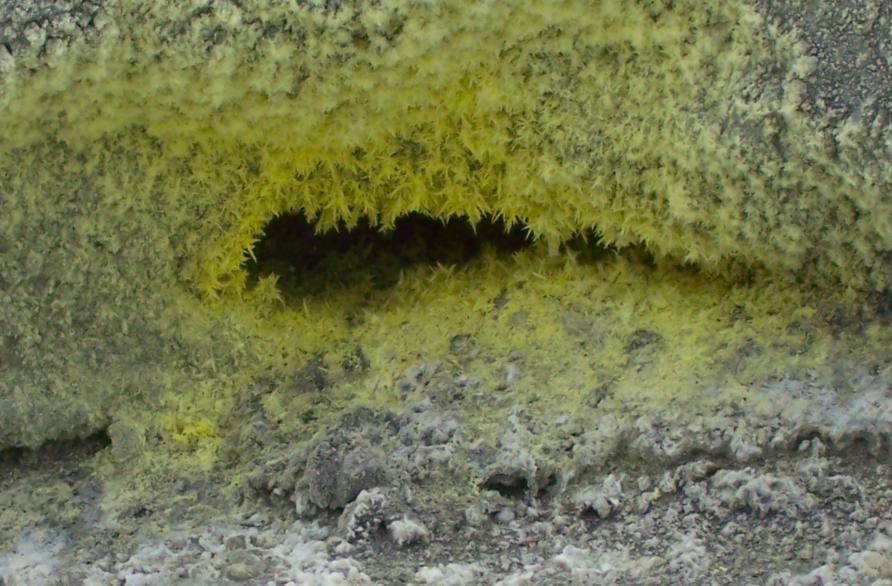
The steam and gas leaves deposits of bright yellow sulfur.
Once ashore we were issued with hard hats and respirators (protection against the toxic gases) and warned to stay close to our guides and not go poking around on our own.
We walked up a slope until we were in a basin, with walls of volcanic tuff (ash transformed into rock) on three sides.
It was a ‘living’ version of what I’d experienced at Mount Franklin, an extinct or maybe just dormant volcano in Australia’s rural Victoria, where it’s possible to drive into the caldera through a gap in the volcano wall.
Mount Franklin is a safe haven on the volcanic plain, but on White Island the acrid smell of sulfur dioxide was very strong – a warning that this was a very dangerous place.
There is a geological connection between White island and the safer tourism precinct at Rotorua, but the gaseous emissions at the two places are quite different.
At Rotorua, it’s hydrogen sulphide (the rotten egg gas many of us may associate with volcanoes), but you don’t notice it after a while, because it deadens the sense of smell.
On White Island, the noxious gas is sulfur dioxide and there’s no mistaking it, no matter how long you are exposed.
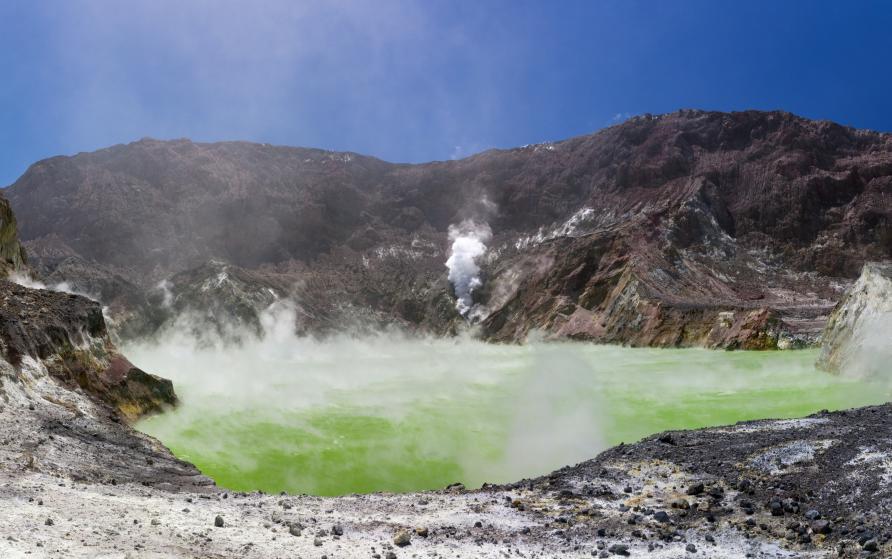
The large crater on White Island contains a lake.
White Island is geologically interesting and easily accessible. It’s relatively close to home for Australians, and there’s no need to trek through the forest or to climb mountains (as Indonesia’s Mount Bromo demands).
I’ve been in and on the old volcanoes in Victoria, and I’ve watched the lava flow into the sea on Hawaii’s Big Island, but White Island was different.
In places, there were bubbling pools, and yellow crusts on the rocks. I was most interested in the dry holes (fumaroles) where steam and other gases poured out and there were deposits of bright yellow sulfur.
Some of it beautifully crystalline, and that appealed to a chemist, who recognises purity when he sees it.
Further into White Island, we climbed again to a ledge looking down into a very nasty lake. The major emission was on the far side and there was monitoring gear on the slope at our feet. In fact, the increased volcanic activity recorded by that equipment led to New Zealand’s science agency GeoNet raising the alert level on the island.
On the far side of the island were the remains of the sulfur factory that was once mined here, smashed up by the major eruption of September 1914.
We could see the skeletons of furnaces where sulfur was melted to separate it from the rock. At the time, sulfur was a valuable starting material for the chemical industry, notably in Victoria, where it was used to make sulfuric acid.
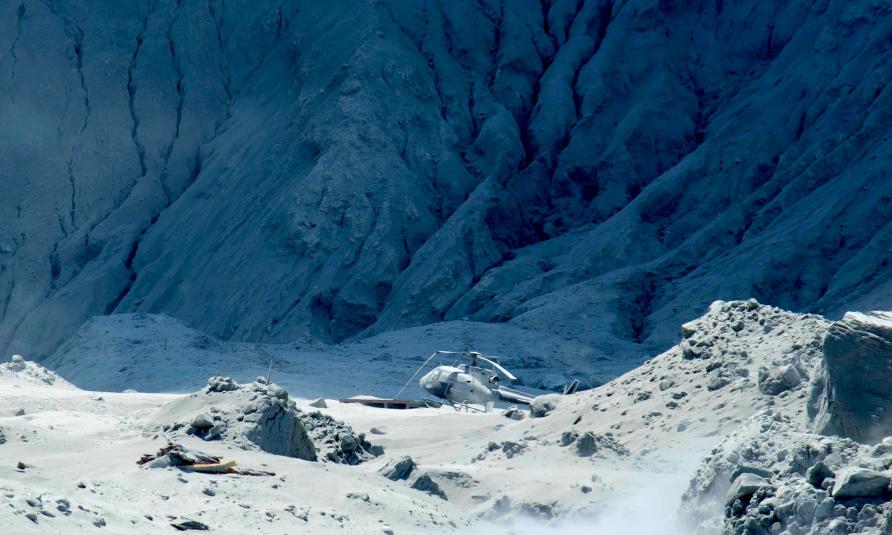
A damaged helicopter on White Island after the recent volcanic eruption.
But the 1914 eruption killed 12 sulfur miners there and brought an end to the export of White Island sulfur. The devastation wasn’t discovered for several weeks until the regular supply boat came to the island and found the only survivor … the works’ cat.
More than a hundred years on from that fatal eruption, the recent tragedy reminds us that while getting so close to the raw power of nature is awe inspiring, it comes with big and very real risks.
This article was published by Pursuit.
Ian Rae is an Honorary Professorial Fellow in the School of Chemistry at the University of Melbourne. He has a PhD from the Australian National University and many years of experience with university research, reviews, and industry consulting.








